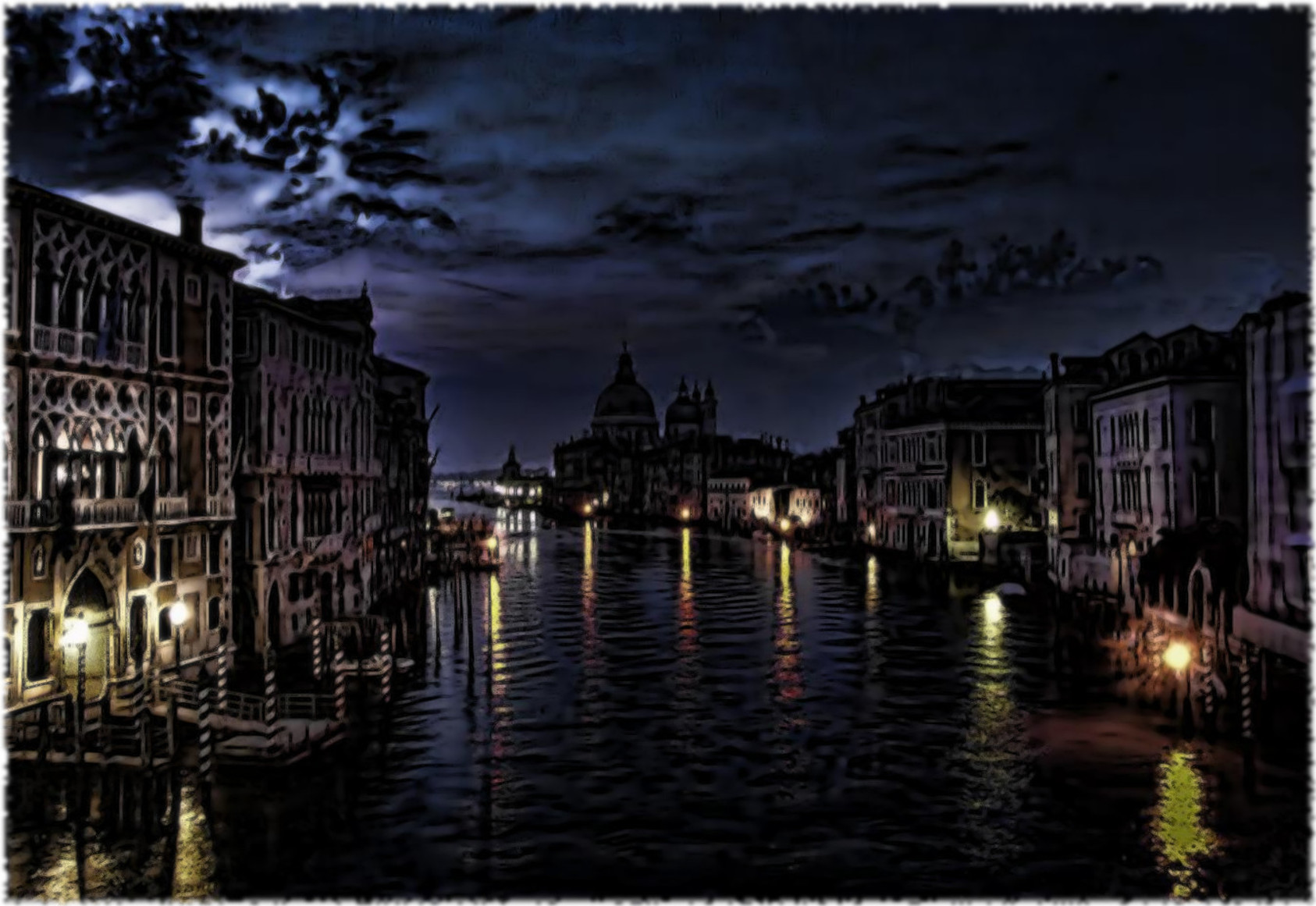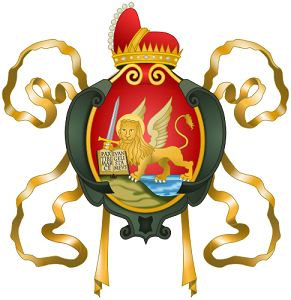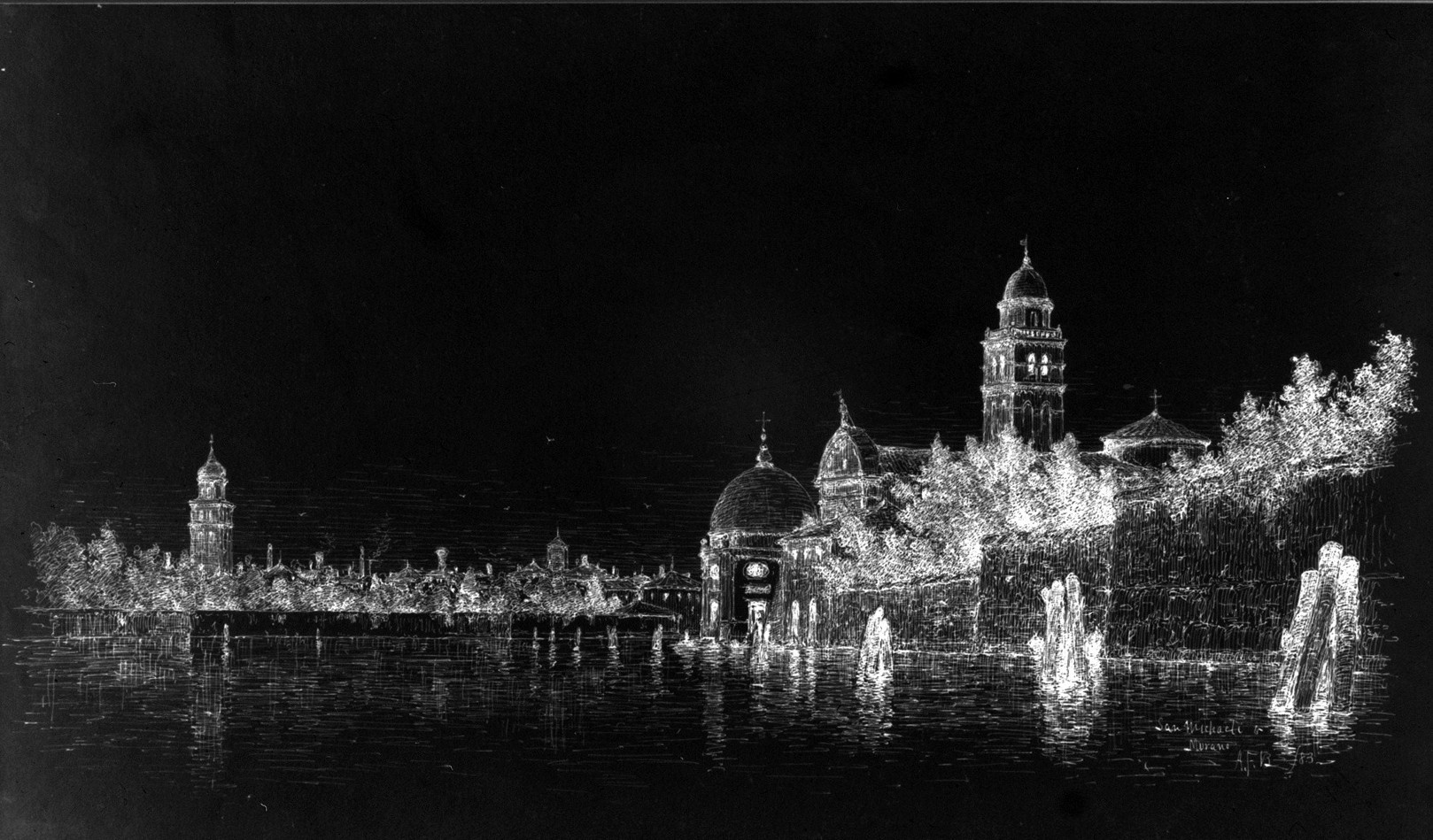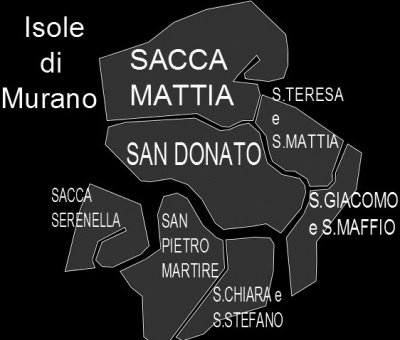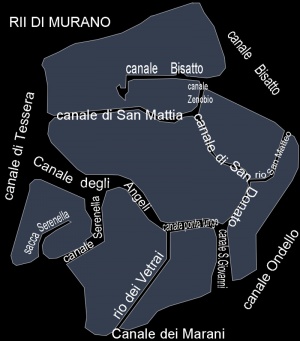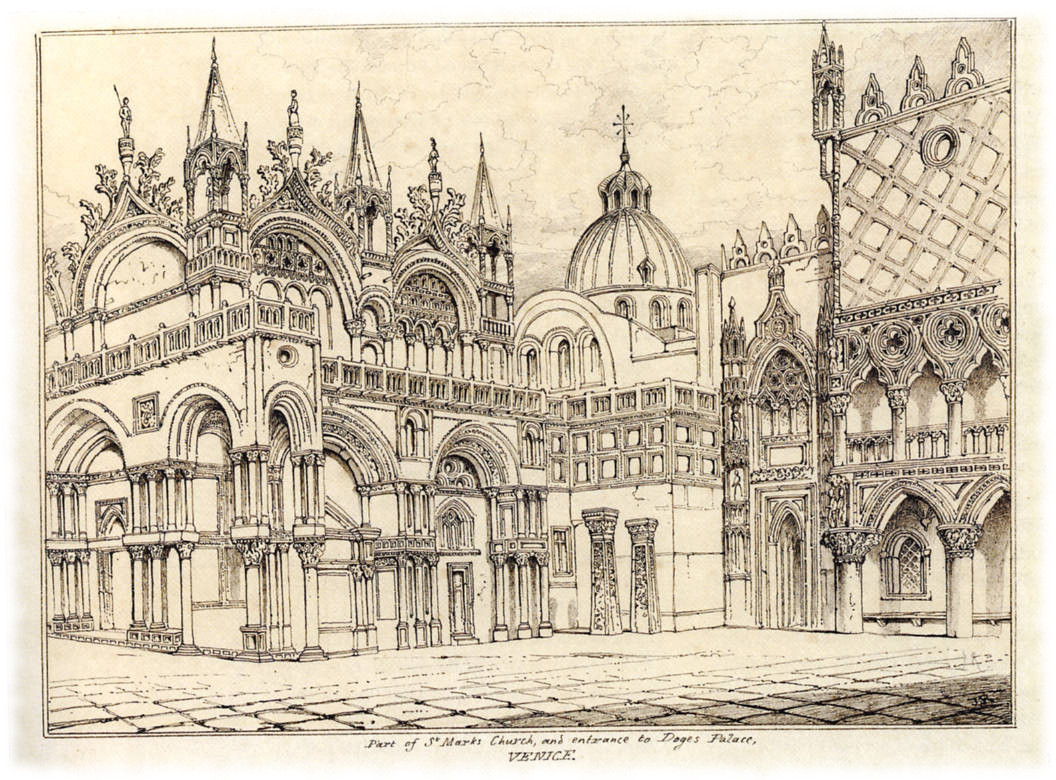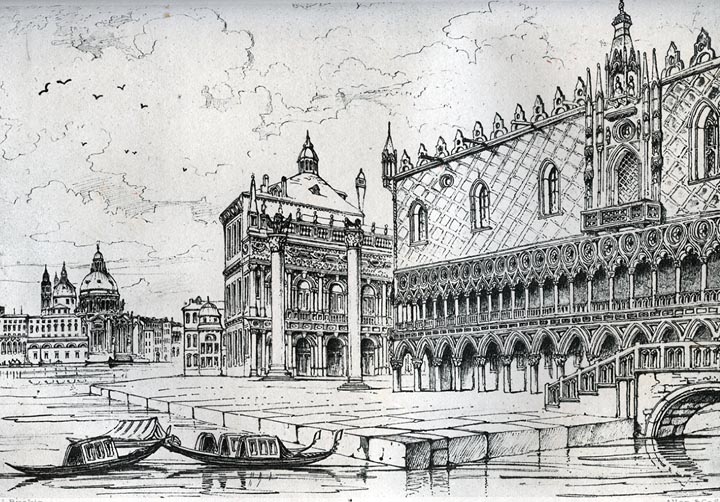Venice -- medieval: Difference between revisions
| Line 98: | Line 98: | ||
==== Maps of Murano ==== | ==== Maps of Murano ==== | ||
[[File:Isole di Murano 1.jpg| | [[File:Isole di Murano 1.jpg|400px]], [[File:Isole di Murano 2.jpg|300px]] | ||
---- | ---- | ||
<br> | <br> | ||
Revision as of 20:21, 21 April 2018
Il Proemio
Called "the Most Serene Commune of Venice" (or La Serenissima), Venice is the second-largest city in Italy, with upwards of 120,000 inhabitants. It is also a hotbed of Cainite intrigue. Catholic Lasombra struggle with their heretical brethren, and the bustling port brings Cainites from across the Mediterranean, all under the watchful eyes of Narses, Prince of Venice and Archbishop of Nod. Therefore, Venice is in the unique position of being a crossroads used by Cainite and kine alike. It is a neutral meeting ground where East meets West and anything can be purchased for a price. Those new to the city may find Venice unsettling, even disturbing.
Aspetto
Clima
Venice has a Humid subtropical climate, with cool winters and very warm summers. Precipitation is spread relatively evenly throughout the year, and averages 29.4 in.
Dispositivo di Città
Economia
Preface
Venice, situated at the far end of the Adriatic Sea, gained large scale profit of the adjacent middle European markets (Eastern European). So did the fact that the town belonged to the Byzantine Empire. Along with increasing autonomy it gained far reaching privileges in both Empires. As a consequence of the Fourth Crusade, the venetian doge became - at least nominally - dominator of three-eighths of Byzantium, all trading ways opened up and a colonial empire, concentrated on the Aegean, developed.
As a consumer center Venice did play a rather meaningless role. But within a long process of adaptation and learning the Venetians developed techniques of trade, forms of companies and methods of finance, but to the same degree means of business development, of insurance and patent protection, in addition technical and organizational innovations, last not least means of controlling the money-market, that made them forerunners of developments for the rest of Europe.
Nevertheless only the nobility or patriciate had the right to exercise the wealth-bringing long-distance trade. It was the same patriciate that erected a monopoly of political leadership. It left production and small business to the strata of its society that were not capable of becoming a member of the council - which was the visible sign of nobility. On the other hand they provided protection against competitors, against violation of secrecy - and exercised strict control.
Ab initio Venice had to face fierce competition and rivalry, especially coming from Genoa. War, whether declared or not, was the normal status that for four times culminated in year-long open wars, conducted with all means. Finally, the tiny - as far as its expanse was concerned - super power had to draw back, because the world powers of those days, Spain and the Ottoman Empire, had a world of natural and human resources, Amsterdam, London and Lisbon the political and economic means that Venice could not afford in that ever growing range.
Introduction
Venice's historical roots reach at least as far back as the Etruscan Culture. The settlements from which later on Venice grew up, could revive the late Roman trade with Northern Italy. At the same time Venice succeeded in extending its privileges in the Byzantine Empire. Byzantium as well as the Holy Roman empire were always prepared to concede privileges to the Venetian traders, when they were in heavy political constraints. These far going privileges - as barbed as they were - formed the judicial basis for the preponderance of the Adriatic town in commercial matters. At the same time it reached its aims to overthrow the Dalmatian and Italian rivals and to secure the routes of transport.
The crusades brought intensification of trade, of which Venice took profit so that it soon ranked first among the trading nations. Already a century before the conquest of Constantinople (1204) lots of traders' colonies flourished. This the more, when the Venetians conquered Crete and other important points that together formed a colonial empire, the backbone of free trade and of the convoys of large ships sent to the markets around the Mediterranean sea. In addition it offered significant opportunities to regulate the local balances of power and secured partly the means of living - especially wheat - for the mother town.
Taking and keeping control of long distance trade from Venice necessitated new means and measures of checking and controlling. The "commercial revolution" with its new cultural, organizational forms, not to forget with its new ways of living, led to a never before seen predominance of economy, especially as the economically leading clans were at the same time incorporated in the vehicles of political power. Economic success attracted - as ever - thousands of people, amongst them many artisans with capabilities of utmost importance, such as the diversification of new artistic techniques and technical processes.
The Crusades and the conquest of the Byzantine capital opened a direct route to Middle-eastern and Asian markets. But these voyages, similar to the costly convoys to Flanders, Tunisia, Syria and Constantinople, required huge amounts of capital, which normally meant credit. This fact is closely combined with the early reduction of barter and a strong position of money-mediated trade. A long learning-process that lead to a rudimentary economic policy started, including patent protection, legal provisions for the opening of trade routes, and provisions to prevent the debasing of trade metals like gold.
The city of Venice could finance its everyday duties via the revenues drawn from tariffs, but in difficult times it rigidly made recourse to the estate and capital of the thousand rich families. Money at its core in those days mostly consisted of gold or silver. As a consequence, the economy depended heavily on the timely increase and decrease of these metals. So Venice had to develop a highly flexible system of currencies and exchange rates between coins consisting of silver and gold, if it wanted to preserve and enhance its role as a platform and turntable of international transaction. In addition the exchange rates between the currencies circulating within and outside of Venice had to be adjusted adequately. On the other hand the nobility had hardly any scruples to force its colonies to accept exchange rates, which were only useful for the rich.
In addition Italian traders were used to means of payment, which could help avoid the transportation of gold and silver, that were particularly expensive and dangerous. Crediting became a way to bridge the ubiquitous lack of noble metals, and at the same time, to accelerate the turnover of goods, these techniques were a primitive form of banking and the creation of letters of credit, the forerunner of paper money. Also available and helpful were to float loans, used as a kind of traders' money, circulating from hand to hand. The moneychangers played as important a role as the later state-controlled banks whose predecessors in Venice were the "wheat chamber" or Camera frumenti.
Despite the predominance of intermediary trade, ship building was an industry of utmost importance right from the beginning - and it was by far the most important employer. Quite important in the later Middle Ages were the production of draperies, silk and glass. Still the salt monopoly was of utmost importance, even more so than the trade in wheat and millet. Indeed, the foundation of patrician wealth lay specifically with this particular trade and it contributed more to their coffers than did the rest of Venice's varied trades.
Geography
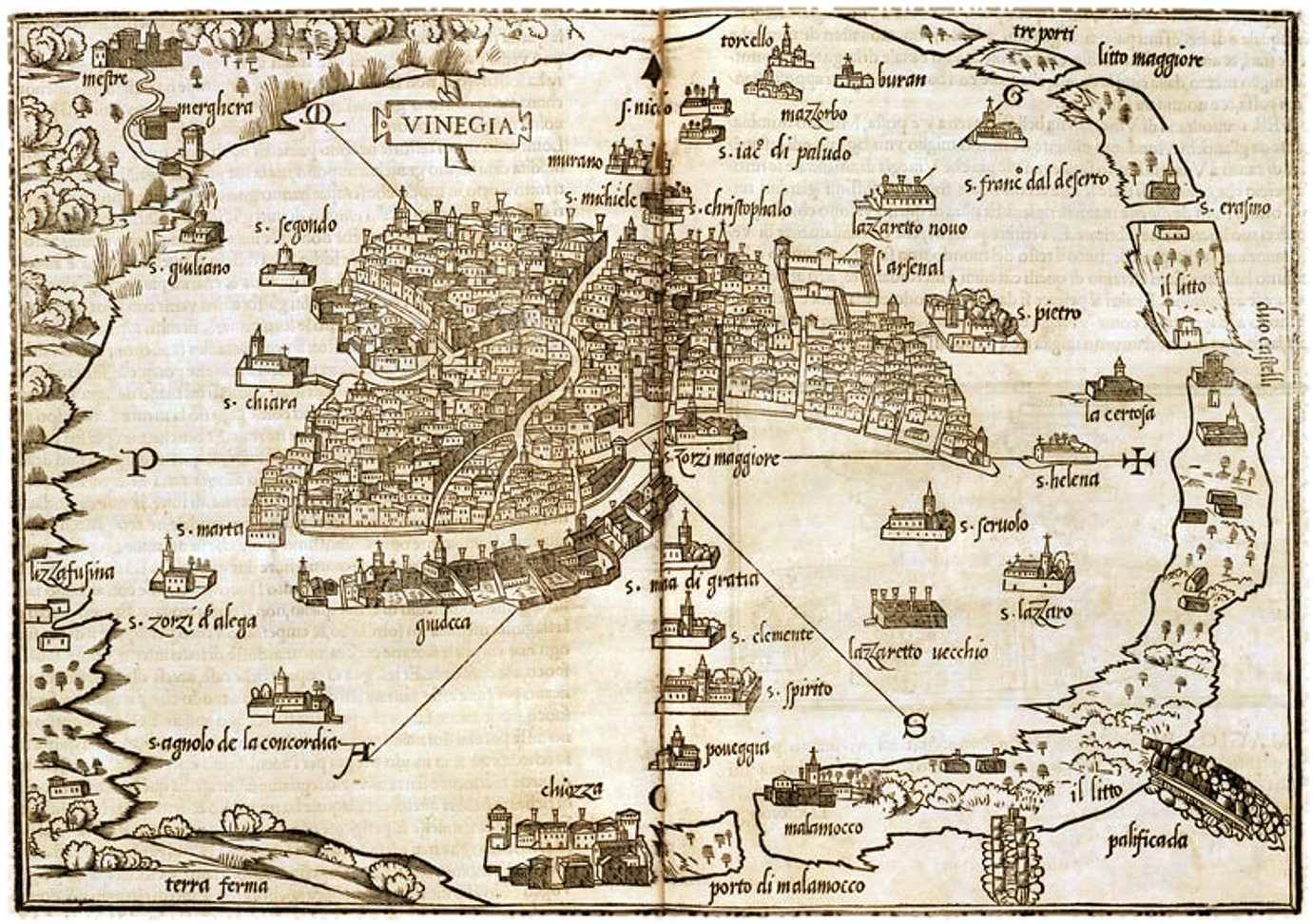
Historically, the city of Venice is divided into six districts called "sestiere." The sestiere are Cannaregio, San Polo, Dorsoduro (including the Giudecca and Isola Sacca Fisola), Santa Croce, San Marco (including San Giorgio Maggiore) and Castello (including San Pietro di Castello and Sant'Elena). Each of the sestiere was administered by a procurator and his staff. In the twenty-first century, the sestiere are just statistical regions, without autonomy from the other districts of Venice. In 1033, the sestiere were originally parishes that numbered seventy, but after Napoleon's conquest of the City, the parishes were reduced to just thirty-eight in number. The parish system predates that of the sestiere or district system which originated in 1170. The other islands of the Venetian Lagoon were never part of the system of sestiere and historically enjoyed a significant degree of autonomy. Each district has its own house numbering system, each house has a unique number within its district and the numbers usually start with one and can rise to multiple thousands; the numbering system can be quite arcane and defies modern logic.
 ,
,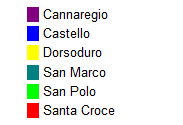
- -- Cannaregio
- -- San Polo
- -- Dorsoduro
- -- Santa Croce
- -- San Marco
- -- Castello
Murano
History
Murano was initially settled by the Romans and from the sixth century by people from Altinum and Oderzo. At first, the island prospered as a fishing port and through its production of salt. It was also a center for trade through the port it controlled on Sant'Erasmo. From the eleventh century, it began to decline as islanders moved to Dorsoduro. It has a Grand Council, like that of Venice, but from the thirteenth century, Murano was ultimately governed by a podestà from Venice. Unlike the other islands in the Lagoon, Murano mints its own coins.
Early in the second millennium hermits of the Camaldolese Order occupied one of the islands, seeking a place of solitude for their way of life. There they founded the Monastery of St. Michael (Italian: S. Michele di Murano). This monastery became a great center of learning and printing. The famous cartographer, Fra Mauro, whose maps were crucial to the European exploration of the world, was a monk of this community. The monastery was suppressed in 1810 by French forces under Napoleon, in the course of their conquest of the Italian peninsula, and the monks were expelled in 1814. The grounds then became Venice's major cemetery.
In 1291, all the glassmakers in Venice were forced to move to Murano due to the risk of fires.[2] In the following century, exports began, and the island became famous, initially for glass beads and mirrors. Aventurine glass was invented on the island, and for a while Murano was the main producer of glass in Europe. The island later became known for chandeliers. Although decline set in during the eighteenth century, glassmaking is still the island's main industry.
In the fifteenth century, the island became popular as a resort for Venetians, and palaces were built, but this later declined. The countryside of the island was known for its orchards and vegetable gardens until the nineteenth century, when more housing was built.
Maps of Murano
Storia
Attualità
Population
- -- 120,000
- Captain Marko -- A young militia man who gains a field promotion via his bosses death at the claws of a Tzimisce in Zulo shape. (actually Brian's character)
- Alfeo -- A young militia man with a weak stomach.
- Ansovald -- Tutor to Augustus Giovanni
- Daniela -- Young server at the Sacred Gull (tavern) and sometimes whore, she often serviced Pompeo and was horrified by his death.
- Eustachio -- Sailor and enemy of the dead sailor Pompeo.
- Gasparo Ungaro -- Signore & Councilor (the first councilor of Isola di Murano that Marko has met)
- Evaristo Dinapoli -- Signore & Councilor with a hound headed dagger.
- Pompeo & Naldo -- Sailors (both deceased along with Naldo's entire family).
Cemeteries
Fortifications
Holy Ground
Churches
Convents
Inns
Landmarks
- -- Palazzo Ducale (The Doge's Palace)
- -- Rialto Bridge
Law & Lawlessness
Monuments
Private Residences
- -- Casa di Giovanni -- The Mausoleum
Taverns
Visitors
- Talib Samara -- Moorish Pirate
Whore Houses
The Vampires of Venice
Cappadocians
- Goffredo Adimari -- A Cappadocian monk from
The Giovanni Bloodline
- Augustus Giovanni -- Third Generation Progenitor of the Giovanni Clan of Vampires
- Ambrogino Giovanni -- Giovanni Savant
- Ignazio Giovanni -- Scourge of Venice
Lasombra
- Narses -- Archbishop of Nod and Prince of Venice
- Guilelmo Aliprando -- Seneschal of Venice
Toreador
- Vasileios Michelakis -- Artisan of Glass
Websites
http://en.wikipedia.org/wiki/Venice
http://visualovation.typepad.com/theartofcarnivaleinvenice/2011/01/once-upon-a-mask-3.html {Golden Masks}
